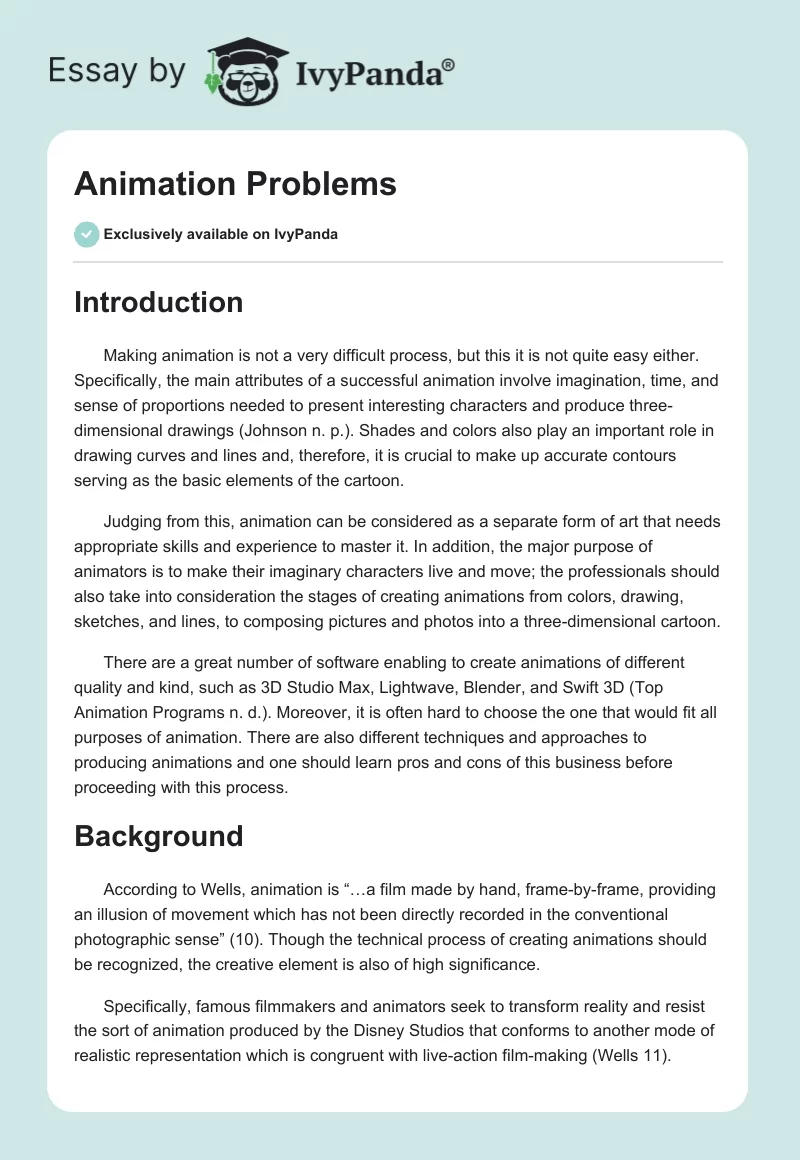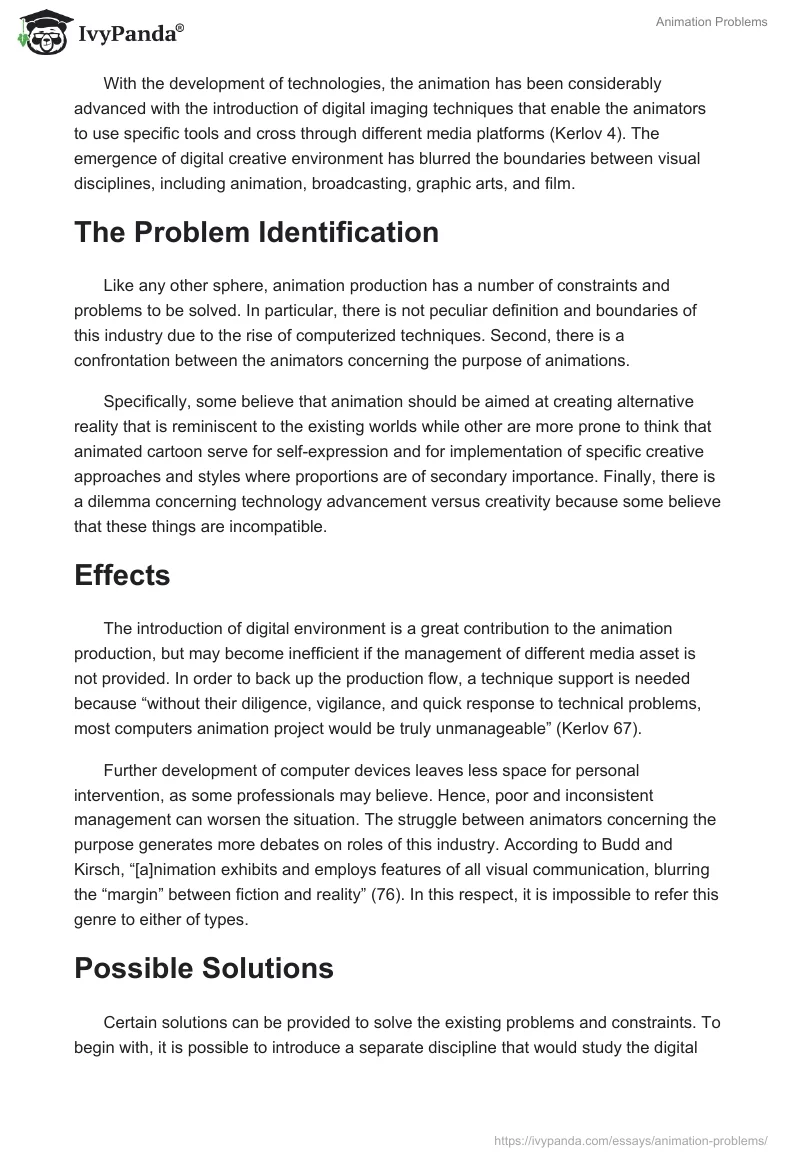Introduction
Making animation is not a very difficult process, but this it is not quite easy either. Specifically, the main attributes of a successful animation involve imagination, time, and sense of proportions needed to present interesting characters and produce three-dimensional drawings (Johnson n. p.). Shades and colors also play an important role in drawing curves and lines and, therefore, it is crucial to make up accurate contours serving as the basic elements of the cartoon.
Judging from this, animation can be considered as a separate form of art that needs appropriate skills and experience to master it. In addition, the major purpose of animators is to make their imaginary characters live and move; the professionals should also take into consideration the stages of creating animations from colors, drawing, sketches, and lines, to composing pictures and photos into a three-dimensional cartoon.
There are a great number of software enabling to create animations of different quality and kind, such as 3D Studio Max, Lightwave, Blender, and Swift 3D (Top Animation Programs n. d.). Moreover, it is often hard to choose the one that would fit all purposes of animation. There are also different techniques and approaches to producing animations and one should learn pros and cons of this business before proceeding with this process.
Background
According to Wells, animation is “…a film made by hand, frame-by-frame, providing an illusion of movement which has not been directly recorded in the conventional photographic sense” (10). Though the technical process of creating animations should be recognized, the creative element is also of high significance.
Specifically, famous filmmakers and animators seek to transform reality and resist the sort of animation produced by the Disney Studios that conforms to another mode of realistic representation which is congruent with live-action film-making (Wells 11).
With the development of technologies, the animation has been considerably advanced with the introduction of digital imaging techniques that enable the animators to use specific tools and cross through different media platforms (Kerlov 4). The emergence of digital creative environment has blurred the boundaries between visual disciplines, including animation, broadcasting, graphic arts, and film.
The Problem Identification
Like any other sphere, animation production has a number of constraints and problems to be solved. In particular, there is not peculiar definition and boundaries of this industry due to the rise of computerized techniques. Second, there is a confrontation between the animators concerning the purpose of animations.
Specifically, some believe that animation should be aimed at creating alternative reality that is reminiscent to the existing worlds while other are more prone to think that animated cartoon serve for self-expression and for implementation of specific creative approaches and styles where proportions are of secondary importance. Finally, there is a dilemma concerning technology advancement versus creativity because some believe that these things are incompatible.
Effects
The introduction of digital environment is a great contribution to the animation production, but may become inefficient if the management of different media asset is not provided. In order to back up the production flow, a technique support is needed because “without their diligence, vigilance, and quick response to technical problems, most computers animation project would be truly unmanageable” (Kerlov 67).
Further development of computer devices leaves less space for personal intervention, as some professionals may believe. Hence, poor and inconsistent management can worsen the situation. The struggle between animators concerning the purpose generates more debates on roles of this industry. According to Budd and Kirsch, “[a]nimation exhibits and employs features of all visual communication, blurring the “margin” between fiction and reality” (76). In this respect, it is impossible to refer this genre to either of types.
Possible Solutions
Certain solutions can be provided to solve the existing problems and constraints. To begin with, it is possible to introduce a separate discipline that would study the digital approaches to creating three-dimensional pictures, which will involve the introduction of several definitions of this notion.
In particular, now animation can be considered not a film made by hand, but with the help of digital creating environment. A more accurate identification of terms will also clarify the issue concerning the creativity and self-expression (Parent 26). In fact, using technologies does not mean insufficient involvement into creative process because tools cannot modify the individualism of the cartoon but foster the process of production.
Closing
In whole, the animation industry is still developing and, therefore, professionals are constantly introducing different approaches and techniques aimed improving the quality of three-dimensional images. Besides, this area is quite popular among the viewers who perceive this art from different perspectives.
Conclusion
In conclusion, it can be stated that animation is one of the developing industries that is closely associated with art, cinematography, and photography. Due to its diverse specialization, it is often hard to define strict frames of its purposes and goals. In order to solve these problems, new definitions, categories, and terms should be introduced for the field to develop successfully. Besides, animators and filmmakers should decide upon genres and styles of animation.
Works Cited
Budd, Mike, and Max H. Kirsch. Rethinking Disney: Private Control, Public Dimensions. US: Wesleyan University Press, 2005. Print.
Johnson, Trevor. “How To Draw 3D Cartoons Quickly And Easily”. EzineArticles, 2001. Web.
Kerlow, Isaac. The Art of 3-D Computer Animation and Effects. New York: Wiley, 2003. Print.
Parent, Rick. Computer Animation: Algorithms and Techniques. US: Morgan Kaufman, 2002.
“Top Animation Programs.” animation programs. Animation Programs, 2011. Web.
Well, Paul. Understanding Animation. New York: Routledge, 1998. Print.




